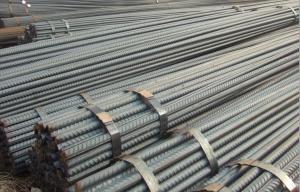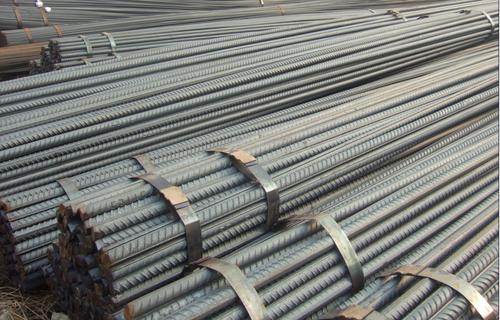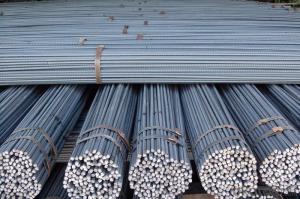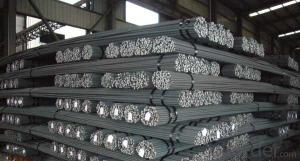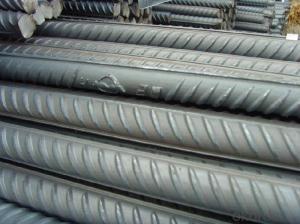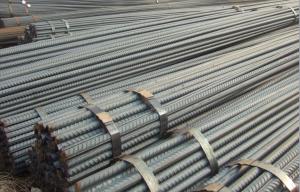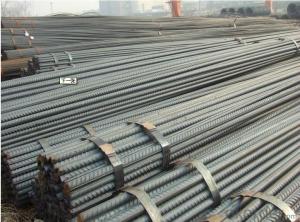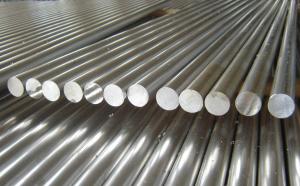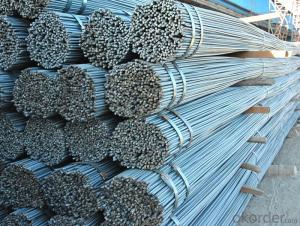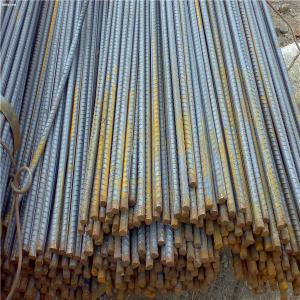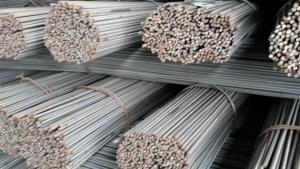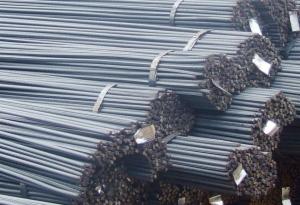Deformed Bar 6MM-50MM BS4449 B500B Or GB HRB
- Loading Port:
- China Main Port
- Payment Terms:
- TT or LC
- Min Order Qty:
- -
- Supply Capability:
- -
OKorder Service Pledge
OKorder Financial Service
You Might Also Like
Product Description:
OKorder is offering high quality Deformed Bar 6MM-50MM BS4449 B500B Or GB HRB at great prices with worldwide shipping. Our supplier is a world-class manufacturer of steel, with our products utilized the world over. OKorder annually supplies products to European, North American and Asian markets. We provide quotations within 24 hours of receiving an inquiry and guarantee competitive prices.
Product Applications:
Deformed bar is widely used in buildings, bridges, roads and other engineering construction. Big to highways, railways, bridges, culverts, tunnels, public facilities such as flood control, dam, small to housing construction, beam, column, wall and the foundation of the plate, deformed bar is an integral structure material. With the development of world economy and the vigorous development of infrastructure construction, real estate, the demand for deformed bar will be larger and larger
Product Advantages:
OKorder's Deformed Bar 6MM-50MM BS4449 B500B Or GB HRB are durable, strong, and resist corrosion, exact size, regular package, chemical and mechanical properties are stable.
Main Product Features:
· Premium quality
· Prompt delivery & seaworthy packing (30 days after receiving deposit)
· Corrosion resistance
· Can be recycled and reused
· Mill test certification
· Professional Service
· Competitive pricing
Product Specifications:
Manufacture: Hot rolled
Grade: BS4449
Certificates: ISO, SGS, BV, CIQ
Diameter: 6mm,8mm,10mm,12mm,14mm,16mm,18mm,20mm,
22mm,25mm,28mm,32mm,36mm,40mm,50mm
Length: 6M, 9M,12M or as required
Packaging: Export packing, nude packing, bundled
Chemical Composition: (Please kindly find our chemistry of our material based on HRB500 as below for your information)
Grade | Technical data of the original chemical composition (%) | ||||||
C | Mn | Si | S | P | V | ||
HRB400 | ≤0.25 | ≤1.60 | ≤0.80 | ≤0.045 | ≤0.045 | 0.04-0.12 | |
Physical capability | |||||||
Yield Strength (N/cm²) | Tensile Strength (N/cm²) | Elongation (%) | |||||
≥400 | ≥570 | ≥14 | |||||
Theoretical weight and section area of each diameter as below for your information:
Diameter(mm) | Section area (mm²) | Mass(kg/m) | Weight of 12m bar(kg) |
6 | 28.27 | 0.222 | 2.664 |
8 | 50.27 | 0.395 | 4.74 |
10 | 78.54 | 0.617 | 7.404 |
12 | 113.1 | 0.888 | 10.656 |
14 | 153.9 | 1.21 | 14.52 |
16 | 201.1 | 1.58 | 18.96 |
18 | 254.5 | 2.00 | 24 |
20 | 314.2 | 2.47 | 29.64 |
22 | 380.1 | 2.98 | 35.76 |
25 | 490.9 | 3.85 | 46.2 |
28 | 615.8 | 4.83 | 57.96 |
32 | 804.2 | 6.31 | 75.72 |
36 | 1018 | 7.99 | 98.88 |
40 | 1257 | 9.87 | 118.44 |
50 | 1964 | 15.42 | 185.04 |
FAQ:
Q1: Why buy Materials & Equipment from OKorder.com?
A1: All products offered byOKorder.com are carefully selected from China's most reliable manufacturing enterprises. Through its ISO certifications, OKorder.com adheres to the highest standards and a commitment to supply chain safety and customer satisfaction.
Q2: How do we guarantee the quality of our products?
A2: We have established an advanced quality management system which conducts strict quality tests at every step, from raw materials to the final product. At the same time, we provide extensive follow-up service assurances as required.
Q3: How soon can we receive the product after purchase?
A3: Within three days of placing an order, we will begin production. The specific shipping date is dependent upon international and government factors, but is typically 7 to 10 workdays.
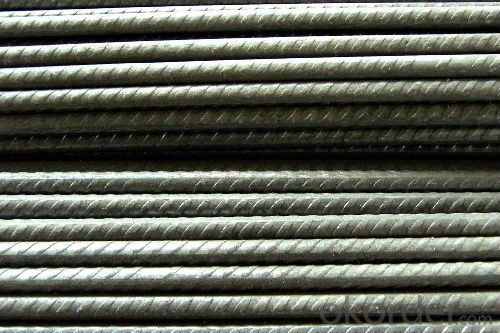
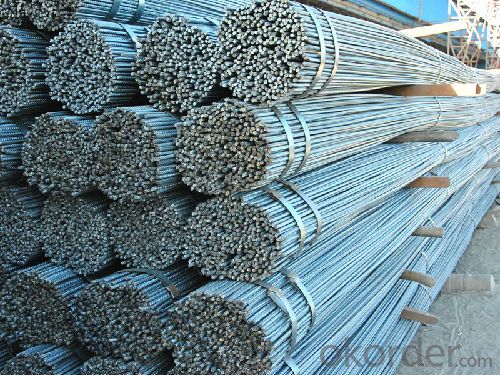
- Q: Is the theoretical weight of threaded steel and round steel the same?
- The difference between such rebar and round bars with longitudinal ribs and transverse rib surface, usually with two longitudinal ribs and transverse ribs along the length direction of the uniform distribution.
- Q: Can steel rebars be used in the construction of residential communities?
- Yes, steel rebars can be used in the construction of residential communities. Steel rebars are commonly used in the construction industry for reinforcing concrete structures, including residential buildings. They provide strength and durability to the concrete, improving its load-bearing capacity and resistance to cracks and other forms of structural damage. Steel rebars are often used in residential construction to reinforce foundation footings, walls, columns, and beams. They help to ensure the structural integrity of the building, making it safer and longer-lasting. Additionally, steel rebars can be easily customized and shaped to fit specific design requirements, allowing for flexibility in construction. Overall, the use of steel rebars in residential communities is a common and widely accepted practice in the construction industry.
- Q: What are the benefits of using stainless steel rebars?
- Some benefits of using stainless steel rebars include their high corrosion resistance, durability, and strength. Stainless steel rebars do not rust or corrode like traditional steel rebars, making them ideal for construction projects in areas with high humidity or exposure to corrosive elements. They also have a longer lifespan, reducing the need for frequent replacements and maintenance. Additionally, stainless steel rebars offer better structural integrity and can withstand higher loads, ensuring the longevity and safety of the structures they reinforce.
- Q: What's the difference between primary and two grade steel and three grade steel?
- There are two kinds of commonly used classification methods of thread steel: one is to shape classification, according to different space shapes and transverse rib rib for classification or type, such as the British Standard (BS4449), the thread steel is divided into type I and type ii. This classification mainly reflects the tightening performance of the threaded steel.
- Q: Can steel rebars be used in structures with high alkaline environments?
- Structures with high alkaline environments, like concrete, generally allow for the use of steel rebars. Nevertheless, it is crucial to take into account the potential for corrosion in such environments. The alkaline nature of concrete forms a protective layer, known as a passive film, on the surface of the steel rebar, which aids in preventing corrosion by reducing contact between the steel and corrosive elements. However, several factors can impact the corrosion resistance of steel rebars in high alkaline environments. These factors encompass the quality of the concrete, the presence of chloride ions (which can disrupt the passive film), the extent of environmental exposure, and the design of the structure. Ensuring that high-quality concrete is used and taking measures to minimize the presence of contaminants that may accelerate corrosion are of utmost importance. In cases where the alkaline environment is highly aggressive or the structure is subject to severe conditions, additional protective measures might be required. These measures can include the application of corrosion-resistant coatings or the implementation of cathodic protection systems to mitigate the risk of corrosion. In conclusion, careful consideration of the specific conditions and appropriate measures are essential when using steel rebars in structures with high alkaline environments. Consulting with structural engineers and corrosion specialists can aid in determining the most suitable approach for utilizing steel rebars in such settings.
- Q: How are steel rebars tested for quality and strength?
- Steel rebars are tested for quality and strength through a series of standardized tests. These tests ensure that the rebars meet the required standards and can withstand the expected loads and stresses. One common test is the Tensile Test, which measures the maximum amount of stress a rebar can withstand before it breaks. In this test, a sample rebar is pulled until it fractures, and the force required to break it is measured. This test provides valuable information about the rebar's ultimate tensile strength, yield strength, and elongation. Another important test is the Bend Test, which evaluates the rebar's ductility and ability to withstand bending without breaking. In this test, a sample rebar is bent to a specific angle, and any cracks or fractures are closely examined. The rebar is deemed acceptable if it doesn't show any signs of failure. Additionally, Chemical Analysis is performed to determine the chemical composition of the rebar. This test ensures that the steel meets the required chemical composition standards, as different compositions can affect the rebar's strength and durability. Furthermore, the Dimensional Test checks the dimensions, weight, and shape of the rebar to ensure they comply with the specified standards. Any deviations from the required measurements can compromise the rebar's structural integrity. Moreover, the rebar's Surface Condition is examined visually to assess any signs of rust, cracks, or other defects that may affect its performance. Proper surface condition is crucial as it ensures good bonding with the surrounding concrete. Finally, some rebars undergo Non-Destructive Testing such as ultrasonic testing or magnetic particle inspection to detect any hidden defects or cracks that may not be visible to the naked eye. Overall, these testing methods are employed to ensure that steel rebars have the required quality and strength to be used in construction projects, providing the necessary reinforcement for reinforced concrete structures.
- Q: How do steel rebars affect the aesthetics of a construction project?
- Steel rebars, an essential element of reinforced concrete structures, have a significant influence on the aesthetics of construction projects. Although their primary purpose is to provide strength and reinforcement to concrete, their presence can have an impact on the overall appearance of the project. The visibility of steel rebars is one way they affect aesthetics. In infrastructure projects like bridges or parking garages, it is common to leave rebars exposed during construction. This exposure can create a distinct industrial or modern look that some find aesthetically pleasing. Architects and designers may intentionally embrace this raw and utilitarian appearance to achieve a specific aesthetic vision. However, in many architectural projects, particularly those involving residential or commercial buildings, the visibility of steel rebars is often undesirable. In such cases, rebars are typically concealed within the structure and covered with finishes such as concrete, plaster, or decorative cladding. This approach enhances the aesthetics of the construction project by shifting the focus from structural elements to the overall design and finishes. Furthermore, the placement and arrangement of rebars can also impact aesthetics. In intricate architectural designs, rebars must be precisely positioned to ensure the desired structural integrity. This presents challenges for designers as they strive to achieve functionality and visual appeal. However, with careful planning and coordination, rebars can be strategically placed to minimize their visual impact while maintaining the desired aesthetics of the project. It is important to note that aesthetics should never compromise the safety and structural integrity of a construction project. While efforts can be made to conceal or minimize the visual impact of steel rebars, proper installation and adherence to engineering standards must always take priority. Ultimately, the aesthetic impact of steel rebars on a construction project depends on the design intent, architectural style, and the balance between functionality and visual appeal.
- Q: Can steel rebars be used in nuclear power plants?
- Indeed, steel rebars are suitable for deployment in nuclear power plants. They are extensively employed in diverse construction undertakings, including nuclear power plants, to fortify concrete structures. By doing so, these rebars enhance the durability and resilience of the concrete, bolstering its capacity to endure various burdens and forces. It is worth noting, however, that the utilization of steel rebars in nuclear power plants necessitates adherence to specific regulations and standards. These regulations might encompass criteria regarding the type of steel employed, its composition, and mechanical characteristics. Furthermore, the rebars must undergo meticulous quality control procedures to ensure that they conform to the required standards and are devoid of any flaws that could jeopardize the structural soundness of the power plant. On the whole, steel rebars can be employed securely in nuclear power plants, provided they satisfy the necessary regulatory requisites and quality control measures.
- Q: How do steel rebars impact the overall flexibility of a structure?
- Steel rebars, also referred to as reinforcing bars, play a crucial role in enhancing the overall flexibility of a structure. These bars are typically utilized in reinforced concrete structures to bolster tensile strength and enhance the structural integrity of the building. The integration of steel rebars in concrete significantly augments the flexibility of a structure. Concrete itself possesses strength in compression but weakness in tension. By incorporating rebars, the structure becomes more adept at withstanding tensile forces and resisting bending or deformation caused by external loads or environmental factors. The rebars function as reinforcement by assimilating and dispersing tensile forces throughout the structure, aiding in the prevention of cracks and ensuring a more uniform distribution of stress. This is particularly vital in regions prone to seismic activity or high wind loads, where structures must possess the ability to flex and absorb the energy exerted upon them. Furthermore, the presence of steel rebars also permits the creation of thinner and lighter concrete sections. This contributes to the overall flexibility of the structure by reducing the dead load, rendering it more responsive and adaptable to diverse conditions. In summary, steel rebars have a significant impact on the overall flexibility of a structure by furnishing tensile strength, averting cracks, distributing stress, and enabling the implementation of lighter and thinner concrete sections. By enhancing the structural integrity and resilience, the inclusion of rebars ensures that the building can withstand external forces while preserving its stability and flexibility, ultimately contributing to its longevity and safety.
- Q: How are steel rebars protected against accidental damage during construction?
- Steel rebars are protected against accidental damage during construction through a variety of measures. One common method is to place plastic caps on the ends of the rebars to prevent them from getting damaged or bent. Additionally, rebars can be covered with plastic or foam sleeves to provide an added layer of protection. Construction workers are also trained to handle rebars carefully and avoid any activities that may cause accidental damage.
Send your message to us
Deformed Bar 6MM-50MM BS4449 B500B Or GB HRB
- Loading Port:
- China Main Port
- Payment Terms:
- TT or LC
- Min Order Qty:
- -
- Supply Capability:
- -
OKorder Service Pledge
OKorder Financial Service
Similar products
Hot products
Hot Searches
Related keywords
